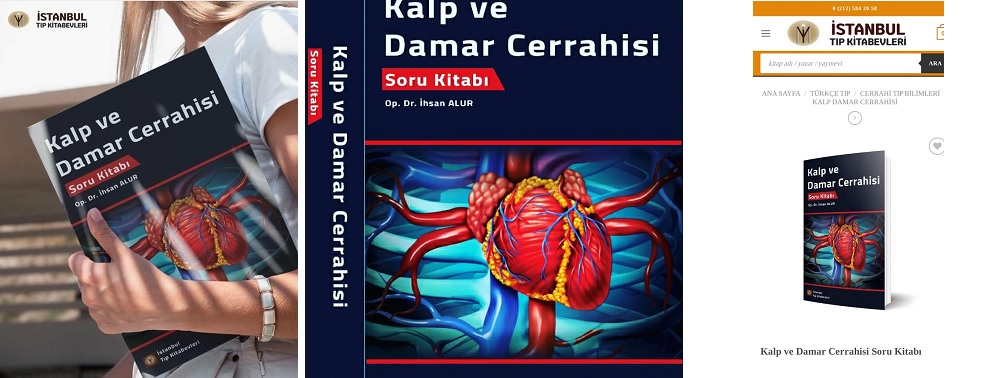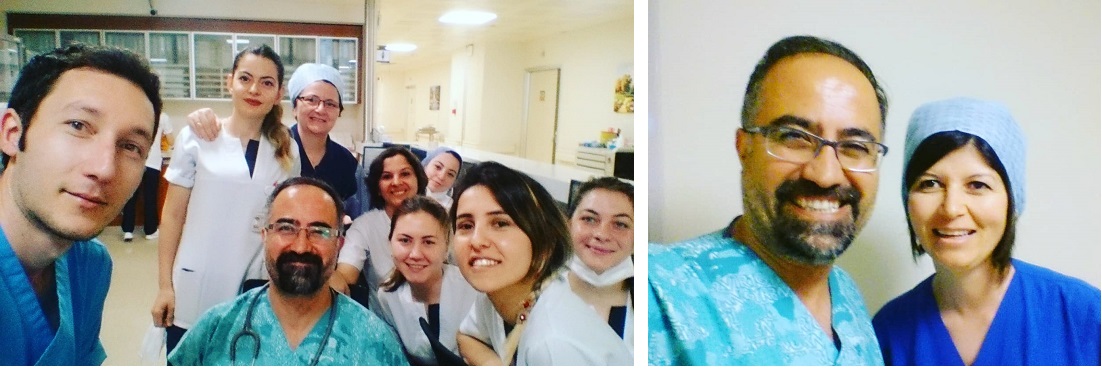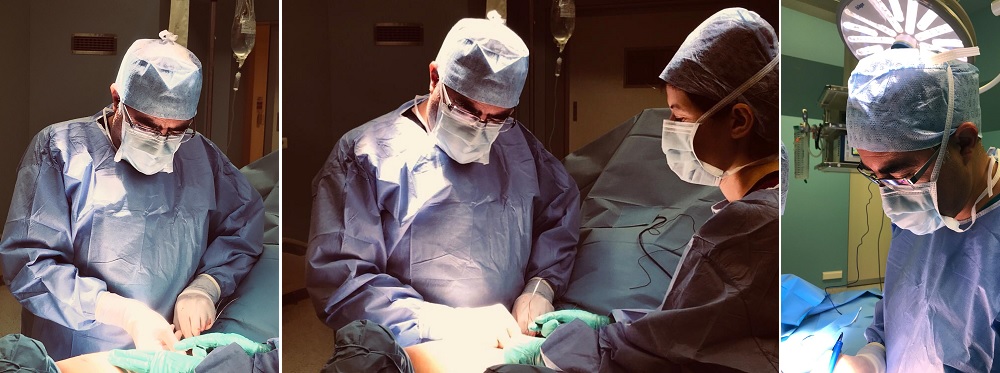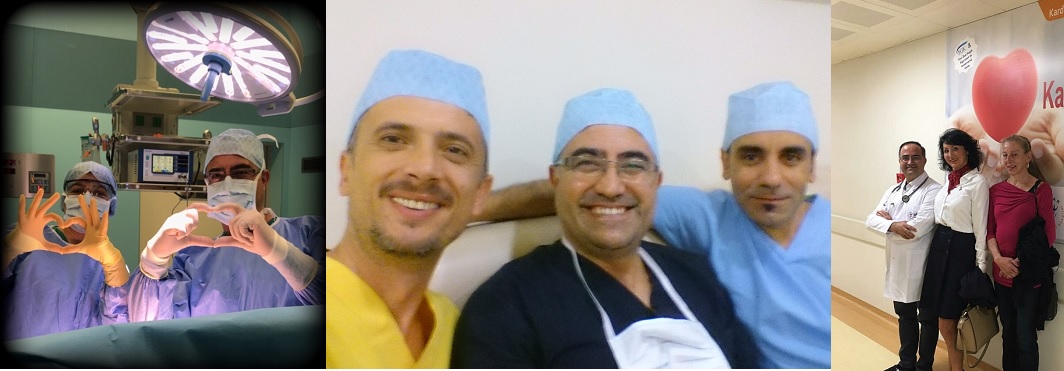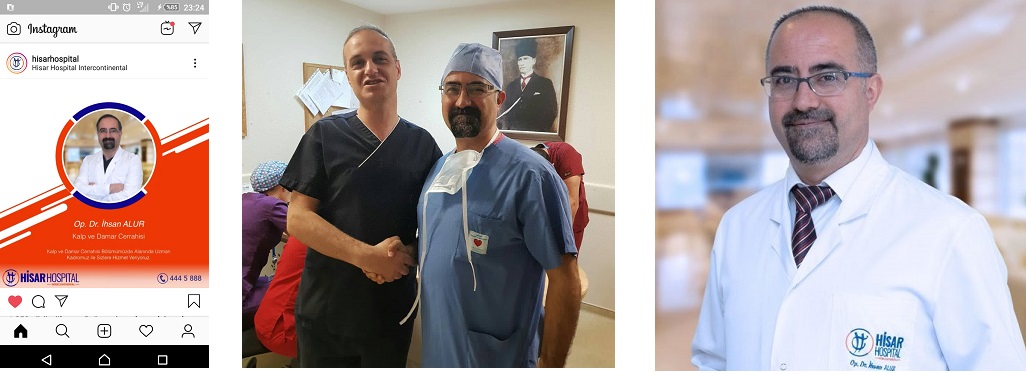Right subclavian artery true aneurysm A rare cause_231106_095614
181
Turk J Vasc Surg 2023;32(3):181-3
DOI: 10.9739/tjvs.2023.08.025
Available online at www.turkishjournalofvascularsurgery.org
Case Report
Corresponding Author: Ihsan Alur, Private Egekent Hospital,
Department of Cardiac and Vascular Surgery, Denizli, Türkiye
Email: alur_i@hotmail.com
Right subclavian artery true aneurysm: A rare cause of dyspnea
Ihsan Alur, Bilgin Emrecan
Private Egekent Hospital, Department of Cardiac and Vascular Surgery, Denizli, Türkiye
Received: August 30, 2023 Accepted: September 25, 2023 Published online: October 18, 2023
Content of this journal is licensed under a Creative Commons Attribution-NonCommercial 4.0 International License.
CITATION
Alur İ, Emrecan B. Right subclavian artery true aneurysm: A rare
cause of dyspnea. Turk J Vasc Surg. 2023;32(3):181-3.
Abstract
Subclavian artery aneurysm (SAA) is a rare condition seen in less than 1% of peripheral artery aneurysms. It is usually asymptomatic. However,
it may become symptomatic as a result of pressure on the surrounding organs due to the progressive growth of the aneurysm. The standard
treatment for SAA is surgery. In this article, we wanted to present a 63-year-old male patient who presented with the complaint of shortness of
breath and was operated on with the diagnosis of Right Subclavian artery true aneurysm on thoracic CT angiography.
Keywords: Subclavian artery, aneurysm, dyspnea, tracheal compression, aneurysmectomy
INTRODUCTION
Subclavian artery aneurysm (SAA) is a rare condition seen in
less than 1% of peripheral artery aneurysms [1]. The causes of
most true SAAs are thoracic outlet syndrome and atherosclerosis,
and rare causes include congenital anomalies (such as aberrant
subclavian artery), fibromuscular dysplasia, cystic medial
necrosis, infection, etc. [1,2]. It is usually asymptomatic.
However, it may become symptomatic as a result of compression
on the surrounding organs due to the progressive growth of the
aneurysm [1]. Dyspnea due to tracheal compression, dysphagia
due to esophageal compression, hoarseness due to right
recurrent laryngeal nerve compression, Horner’s syndrome due
to stellate ganglion compression, and sensory and motor nerve
deficits due to brachial plexus compression may be seen [3].
Its complications are thrombosis, distal embolization, massive
bleeding due to rupture, and sudden death [1,3]. In this article,
we wanted to present a 63-year-old male patient who presented
with the complaint of shortness of breath and who was operated
on with the diagnosis of right Subclavian artery true aneurysm on
thoracic CT angiography.
CASE REPORT
A 63-year-old male patient presented with the complaint of
progressive dyspnea. In the patient’s anamnesis, it was learned
that he had surgery for aortic dissection and ascending aorta
replacement was performed at another health center 5 years
ago. Again, 8 months ago, tube graft interposition (to eliminate
branching) was performed between the right carotid artery
and the left carotid artery due to right CAA at the same health
center. In the right SAA, it was aimed to place a stent graft with
the endovascular method, but endovascular procedure could
not be performed because the aneurysm could not be crossed
with the guide wire. Meanwhile, the enlargement of the SAA
and shortness of breath due to tracheal compression started to
increase gradually. On physical examination, a palpable pulsatile
mass was detected in the right supraclavicular region. Thoracic
CT angiography showed a 56 mm (5.6 cm) right SAA with
severe compression on the trachea and Stanford type A chronic
aortic dissection. (Figure 1A, 1B, 1C, 1D). Aneurysmectomy and
graft interposition to the SAA were planned for the patient with
an open surgical method. Surgical consent was obtained from the
patient. An upper J mini sternotomy was performed with a redo
Turk J Vasc Surg 2023;32(3):181-3 DOI: 10.9739/tjvs.2023.08.025
182
saw under general anesthesia. Fibrous adhesions were carefully
dissected, nerves were preserved, and the proximal part of the
LAA was rotated and suspended with vascular tape (Figure 2A).
Then, the distal part was turned through a mid-subclavicular
incision and the vessel was suspended with tape. After intravenous
administration of 5000 IU Heparin and cross clamping, the
aneurysm sac was opened with a linear incision (Figure 2B). It
was observed that there was a dense mural thrombus in the sac.
Mural thrombi were removed. The proximal and distal parts of
the SAA were ligated with sutured silk. Three lateral branches
connected with the aneurysm sac were ligated and the sac was
isolated from the arterial system. Then, tube graft interposition
was performed between the 8 mm PTFE graft and the mid
segment from the proximal to the subclavian artery (Figure 2C).
In the postoperative physical examination, it was observed that
the pulsatile mass disappeared on palpation and the complaint
of dyspnea no longer existed. The patient was prescribed
Clopidogrel 75 mg once a day and was discharged without any
problems.
Figure 1. A. Giant Subclavian Artery True Aneurysm (yellow arrow), 1B. Giant
Subclavian Artery True Aneurysm (yellow arrow), chronic aortic dissection (red
arrow), severe tracheal compression (black arrow), 1C. ascending aorta gerfti
(red arrow), Subclavian Artery True Aneurysm (yellow arrow), 1D. chronic aortic
dissection (yellow arrow)
Figure 2. A. Intraoperative view of giant Subclavian Artery True Aneurysm
(white arrow), 2B. Intraoperative view of the aneurysm sac and thrombus in
the sac (white arrow), 2C. Truncus brachiocephalicus (black arrow), Proximal
anastomosis of subclavian artery with graft (big white arrow), Distal anastomosis
of subclavian artery with graft (small white arrow)
DISCUSSION
SAA is a rare clinical pathological condition. Its symptoms include
dyspnea, dysphagia, hoarseness, Horner’s syndrome, deficits in
sensory and motor nerves due to brachial plexus compression
(paresis, plegia, paresthesia), superior vena cava syndrome,
ischemia in the upper extremity due to thromboembolism or
infarction due to cerebral embolism [1-3]. In our case, due to
tracheal compression dyspnea was prominent. SAA is mostly
located in the extrathoracic region [3]. However, the aneurysm
in this case was located intrathoracically. SAA usually develops
secondary to atherosclerosis and Thoracic outlet syndrome (TOS)
[4]. There was no TOS finding in our case. However, there was HT
as a risk factor. The history of aortic dissection in our case suggests
that SAA may be related to HT and atherosclerosis. In these cases,
the supraclavicular approach is preferred if the SAA is located
in the extrathoracic region, and the combined supraclavicular
and transsternal approach is preferred if the SAA is located in
the intrathoracic region [3]. In our case, we preferred upper J
mini sternotomy and subclavicular approach due to intrathoracic
SAA. We performed aneurysmectomy + thrombectomy and graft
interposition. In these cases, it is important to pay attention to
the surrounding anatomical structures. In particular, nerve injury
and permanent nerve deficits should be avoided. Resection of the
aneurysm together with the thrombus is important in terms of
eliminating the pressure and preventing thrombic complications.
Endovascular treatment is recommended for anatomical reasons
and to prevent possible complications, especially in high-risk
patients with intrathoracic SAA [5].
CONCLUSION
Our patient had previously been operated on at another health
center. Ascending aortic replacement was performed due to
aortic dissection. An endovascular procedure was planned for
LAA and debranching was performed. However, since the guide
wire could not pass the aneurysm, endovascular procedure could
not be performed. That’s why we applied surgical treatment. In
SAA cases, it is important to pay attention to the surrounding
anatomical structures. In particular, nerve injury and permanent
nerve deficits should be avoided. The proximal and distal regions
of the aneurysm and its lateral branches should be ligated,
resected together with the thrombus inside the aneurysm, and
interpositioned with a graft.
Patient Consent for Publication: Written informed consent was
obtained from the patient for publication of this case report and
accompanying images.
Data Sharing Statement: The data that support the findings
of this study are available from the corresponding author upon
reasonable request.
Author Contributions: All authors contributed equally to the
article.
Turk J Vasc Surg 2023;32(3):181-3 DOI: 10.9739/tjvs.2023.08.025
183
Conflict of Interest: The authors declared no conflicts of interest
with respect to the authorship and/or publication of this article.
Funding: The authors received no financial support for the
research and/or authorship of this article.
REFERENCES
- Wan Q, Zhang X. Left subclavian artery aneurysm complicating
aortic pseudocoarctation. Asian J Surg. 2022;45:1428-9. - Alur İ, Fedakar A, Aksoy SH. Aberrant right subclavian artery
aneurysm: A rare entity. Cardiovasc Surg Int. 2018;5:85-6. - Davidović LB, Marković DM, Pejkić SD, Kovacević NS, Colić
MM, Dorić PM. Subclavian artery aneurysms. Asian J Surg.
2003;26:7-11. - Saba D, Bayram AS, Gebitekin C, Özkan H. Subclavian artery
aneurysm secondary to thoracic outlet syndrome. Damar Cer Derg.
2001;10:45-7. - Marjanović I, Tomić A, Marić N, Pecarski D, Šarac M, Paunović
D, et al. Endovascular treatment of the subclavian artery aneurysm
in high-risk patient – a single-center experience. Vojnosanit Pregl.
2016;73:941-4.
Median arcuate ligament syndrome: What is the best treatment?
Cardiovascular Surgery and Interventions Case Report Open Access Cardiovasc Surg Int 2023;10(3):177-179 http://dx.doi.org/DOI: 10.5606/e-cvsi.2023.1552 www.e-cvsi.org ©2023 Turkish Society of Cardiovascular Surgery. All rights reserved. Cardiovascular Surgery and Interventions, an open access journal www.e-cvsi.org Median arcuate ligament syndrome: What is the best treatment? İhsan Alur, Bilgin Emrecan Received: July 03, 2023 Accepted: August 16, 2023 Published online: October 25, 2023 Corresponding author: İhsan Alur, MD. Özel Egekent Hastanesi Kalp ve Damar Cerrahisi Bölümü, 20125 Merkezefendi, Denizli, Türkiye. E-mail: veyseltemizkan@yahoo.com ABSTRACT Median arcuate ligament syndrome is a rare condition that is usually recognized late. Chronic postprandial abdominal pain, weight loss, loss of appetite, nausea, and diarrhea are usual symptoms due to the median arcuate ligament’s mechanical compression on the celiac trunk and celiac plexus. The gold standard in treatment is to eliminate the mechanical compression of the median arcuate ligament on the celiac trunk and celiac plexus. In this article, we present a 49-year-old female patient who previously underwent endovascular intervention but whose complaints were not relieved and who underwent surgical treatment. Keywords: Abdominal pain, celiac plexus, compression, median arcuate ligament release, surgery. Median arcuate ligament syndrome (MALS) or celiac artery compression syndrome is a condition characterized by abdominal pain, weight loss, and loss of appetite as a result of mechanical compression of the median arcuate ligament on the celiac trunk and celiac plexus. It occurs in an estimated 2/100,000 patients.[1] It is more common in women than men.[1,2] It has also been reported in the pediatric patient group.[1,2] Clinical findings were chronic postprandial abdominal pain in 80% of cases, weight loss in 48%, murmur on auscultation in 35%, nausea in 9.7%, and diarrhea in 7.5%.[2,3] Diagnosis is made by color Doppler ultrasound or computed tomography angiography. Inflammatory bowel diseases and anxiety disorder should be considered in the differential diagnosis. The gold standard in treatment is to eliminate the mechanical compression of the median arcuate ligament on the celiac trunk and celiac plexus. Therefore, surgical treatment seems to be the best option for patients diagnosed with MALS. In this article, a patient who underwent endovascular intervention but whose complaints were not relieved and who underwent surgical treatment was reported. CASE REPORT A 49-year-old female patient had complaints of abdominal pain, fear of eating (cibophobia), weight loss, abdominal distention, belching, constipation, loss of appetite, and nausea that had persisted for five years and had increased since the last six months. In her gastroenterological examination, no pathology could be found to explain these symptoms. Later diagnosed with MALS on computed tomography angiography by interventional radiology. With the conventional mesenteric angiography technique, 80 to 90% stenosis was detected in the celiac artery, and the stenosis was resolved by placing a 6¥27 mm stent (Figure 1a, b). The patient’s abdominal pain complaints disappeared temporarily but started again after one week. In the control angiography performed by the interventional radiologist, the stent was found to be broken (Figure 2a, b), and surgical intervention was recommended to the patient. Open surgical intervention was scheduled after the completion of preoperative evaluations. A median laparotomy was performed above and below the umbilicus, following preparations under sterile conditions under general anesthesia. The celiac trunk, main hepatic artery, splenic artery, left gastric artery, and infrarenal aorta were released by encircling with a vessel tape. The stent was palpated proximal to the celiac trunk. There was no pulse distal to the stent. The ligament on the celiac Department of Cardiovascular Surgery, Private Egekent Hospital, Denizli, Türkiye Citation: Alur İ, Emrecan B. Median arcuate ligament syndrome: What is the best treatment?. Cardiovasc Surg Int 2023;10(3):177-179. doi: 10.5606/e-cvsi.2023.1552. 178 Cardiovasc Surg Int Cardiovascular Surgery and Interventions, an open access journal www.e-cvsi.org trunk and plexus was released with electrocautery. Intravenous 5,000 IU unfractionated heparin was administered. After an appropriate activated clotting time (ACT) was reached (ACT>150), bypass grafting was performed between the infrarenal aorta (Figure 3a) and the main hepatic artery (Figure 3b) using an 8 mm Dacron graft by tunneling from the intestinal mesos behind the stomach and in front of the duodenum/pancreas. The postoperative period was uneventful. The patient was discharged on the sixth postoperative day. DISCUSSION The existence of this disease is still controversial, and its diagnosis depends on the elimination of other possible causes of abdominal pain. The symptoms of MALS may not cause chronic mesenteric ischemia, and the pathophysiology of this disease is still not fully understood. However, a prospective cohort study using ischemia function testing demonstrated long-term benefit in approximately 80% of treated cases.[4] Patients treated nonoperatively appear to have worse outcomes.[2] The main etiology of this disease is anatomical, as the median arcuate ligament mechanically compresses the celiac trunk and celiac plexus. In other words, since the main cause is anatomical, the treatment of the disease is to eliminate this pressure.[2] The stent is broken or kinked due to mechanical compression. In this case, an endovascular intervention was performed one month ago, a stent was placed, but the patient’s complaints started again, as stent fracture occurred one week later. Open surgery, minimally invasive procedures, or laparoscopic methods are applied.[3,5] Figure 1. (a) Severe stenosis and poststenotic dilatation of the celiac artery in computed tomography angiography (yellow arrow); (b) severe stenosis and poststenotic dilatation of the celiac artery on magnetic resonance imaging (yellow arrow). (a) (b) Figure 2. (a) One week after endovascular stent placement, computed tomography angiography (transverse section) shows that the stent is broken and thrombosed (yellow arrow); (b) computed tomography angiography (coronal section) shows that the stent is broken and thrombosed (yellow arrow). (a) (b) Alur İ and Emrecan B. Median arcuate ligament syndrome 179 Cardiovascular Surgery and Interventions, an open access journal www.e-cvsi.org Whatever the method is, it should aim to eliminate compression. Postprandial intestinal angina, cibophobia, weight loss, nausea, and vomiting are prominent complaints in MALS.[2] In our case, epigastric pain/rumbling, cibophobia, abdominal bloating, belching, constipation, loss of appetite, and nausea were present in accordance with the literature. Bypass grafting seems to be the most appropriate surgical treatment in some cases. Revascularization is performed by providing antegrade arterial inflow from the thoracic or supraceliac aorta or retrograde arterial inflow from the infrarenal aorta.[2] For anatomical convenience, we performed bypass grafting between the infrarenal aorta and the main hepatic artery in our case. In MALS, cutting the median arcuate ligament or releasing the fibrotic celiac ganglion by incision relieves pressure to a large extent and provides symptomatic relief.[3,5] The most suitable lesion for an endovascular procedure is a short-segment (<10 cm) lesion close to the celiac artery or superior mesenteric artery ostium.[2] In recent years, minimally invasive or laparoscopic methods have also been applied in appropriately selected patients.[3,5] Long-term follow-up data (over five years) after surgical management are lacking. In our case, stenting was previously performed, the stent was fractured and occluded within a week, symptoms relapsed, and the final treatment was open surgery. Ganglionectomy can also be performed if there is a neuropathic component. The celiac plexus was also released during the surgery. After the surgical treatment, the patient’s complaints disappeared. It was observed that the patient’s complaints completely resolved in the postoperative third month. In conclusion, decompression of the median arcuate ligament’s constriction of the celiac artery and plexus provides symptomatic relief in MALS. Bypass grafting seems to be the most appropriate treatment for the surgical treatment of some cases. Patient Consent for Publication: A written informed consent was obtained from the patient. Data Sharing Statement: The data that support the findings of this study are available from the corresponding author upon reasonable request. Author Contributions: All authors contributed equally to the article. Conflict of Interest: The authors declared no conflicts of interest with respect to the authorship and/or publication of this article. Funding: The authors received no financial support for the research and/or authorship of this article. REFERENCES 1. Iobst TP, Lamb KM, Spitzer SL, Patel RN, Alrefai SS. Median arcuate ligament syndrome. Cureus 2022;14:e22106. doi: 10.7759/cureus.22106. 2. Emrecan B, Önem G, Baltalarlı A. İntestinal anjina: Karın ağrısının ender bir nedeni. Turk Gogus Kalp Dama 2008;16:269-73. 3. Sun Z, Zhang D, Xu G, Zhang N. Laparoscopic treatment of median arcuate ligament syndrome. Intractable Rare Dis Res 2019;8:108-12. doi: 10.5582/irdr.2019.01031. 4. Björck M, Koelemay M, Acosta S, Bastos Goncalves F, Kölbel T, Kolkman JJ, et al. Editor’s choice – management of the diseases of mesenteric arteries and veins: Clinical practice guidelines of the European Society of Vascular Surgery (ESVS). Eur J Vasc Endovasc Surg 2017;53:460-510. doi: 10.1016/j.ejvs.2017.01.010. 5. Birkhold M, Khalifeh A, Nagarsheth K, Kavic SM. Median arcuate ligament syndrome is effectively relieved with minimally invasive surgery. JSLS 2022;26:e2022.00067. doi: 10.4293/JSLS.2022.00067. Figure 3. (a) Intraoperative view of the anastomosis between the infrarenal abdominal aorta and the Dacron graft (yellow arrow); (b) intraoperative view of the anastomosis between the hepatic artery and the Dacron graft (yellow arrow). (a) (b)
Turkish Journal of Vascular Surgery 2020;29(2):127-130
Renal artery embolization following aortobifemoral bypass
34706-42155-1-PB
Olgu Sunumu
Akut Tip B aort diseksiyonlu hastada TEVAR uygulamamız
TEVAR procedure for type B aortic dissection
İhsan Alur, Yusuf izzettin Alihanoğlu, Kadir Gökhan Saçkan, Bülent Çümen, Mustafa Serdar Ateşci
* Denizli Devlet Hastanesi, Kardiovasküler Cerrahi Kliniği, Denizli
Özet
Torasik aorta hastalıkları mortalite ve morbiditesi yüksek olan gruptur. Semptomların başlangıcından itibaren hızlı tanı ve erken müdahale gerektirir. Bu olgu sunumunda TEVAR uyguladığımız kronik böbrek yetersizliği nedeniyle hemodiyaliz uygulanan, antihipertansif tedavi alan ve acil servise şiddetli sırt ağrısıyla başvuran Tip B aort diseksiyonlu 52 yaşında erkek hastayı değerlendirdik.
Pam Tıp Derg 2011;4(3):45-47
Anahtar sözcükler:
Aort diseksiyonu, aortik onarım, TEVAR
Abstract
Thoracic aort diseases have high morbidity and mortality rates. Early diagnsosis and treatment are necessary after the onset of the symptoms. We would like to present a 52 years old male patient who has been given combined antihypertensive drugs and has undergone hemodialysis due to chronic renal failure. This patient applied to the emergency department with the complaint of severe back pain and diagnosed as type B aortic dissection, and afterwards TEVAR procedure was successfully performed.
Pam Med J 2012;5(1):45-47
Key words: Aortic dissection, aortic repair, TEVAR
Olgu Sunumu
52 yaşında erkek hasta şiddetli sırt ağrısıyla başvurdu. Özgeçmişinde kronik böbrek yetersizliğinedeniylehaftadaüçkezhemodiyalize girdiği ve antihipertansif tedavi aldığı öğrenildi. Kontrastlı Bilgisayarlı Tomografide (BT) sol subklavian arterin distalinden başlayıp suprarenal aortaya kadar uzanım gösteren, intramural hematomla sınırlanmış Tip B aortik diseksiyon tespit edildi (Resim 1). Hastaya lokal anestezi ile Thoracic Endo-Vascular Aortic Repair (TEVAR) uygulandı. Hastanın sırt ağrısı tamamen kayboldu. Kontrol BT anjiografi çekildi (Resim 2,3). Diseksiyonun tamamen ortadan kalktığı ve leak olmadığı tespit edildi.
Resim 1. Bilgisayarlı tomografide Tip B aortik diseksiyon görüntüsü (ok).
İhsan Alur
Yazışma Adresi: Denizli Devlet Hastanesi, Kardiovasküler Cerrahi Kliniği,
Denizli e-mail: alur-i@hotmail.com
Gönderilme tarihi: 14.12.2011 Kabul tarihi: 08.02.2012
45
Akut Tip B aort diseksiyonlu hastada TEVAR uygulamamız
Resim 2. TEVAR prosedürü sonrası floroskopi görüntüsü
Resim 3. TEVAR prosedürü sonrası 3 boyutlu BT anjiografi görüntüsü
Tartışma
Torasik aorta diseksiyonu kardiyovasküler hastalıklar arasında mortalitesi oldukça yüksek olan bir hastalıktır [1]. Disekan aort anevrizması veya (aort diseksiyonu) geliştiği andan itibaren erken dönemde her saat başına
%1 erken mortalite oranına sahiptir [2]. Yıllık insidansı, 100.000 kişide 0.5-2.1’dir [3]. Sıklıkla hipertansiyon, kardiyovasküler hastalık (biküspit aort kapak) ya da kollajen doku hastalığının (marfan sendromu) eşlik ettiği sigara içicisi olan 60-65 yaş arası erkeklerde görülür [3]. Aort diseksiyonu erkek cinsiyette iki kat daha sık görülür. Tip B aort diseksiyonunda TEVAR için güncel endikasyonlar genel olarak hastalık progresyonu veya belirgin diseksiyon ve rüptür başlangıcı veya antihipertansif tedaviye rağmen devam eden inatçı göğüs-sırt ağrısını kapsar [4].
TEVAR’ın amacı, başlangıç yırtık bölgesinin ve yalancı lümenin greftle kapatılması, kan akımının gerçek lümene yönlendirilmesidir. Ayrıca yalancı lümenin gerçek lümene basısını azaltarak aortanın ana dallarına antegrad akımın sağlanmasıdır. Bu mekanik bir olay gibi görünse de bu tedavinin özellikle erken dönemde visseral organların perfüzyonunu sağlaması sağkalımı belirleyen başlıca etkendir [5]. Fattori ve ark.nın [6] yaptığı bir çalışmada akut Tip B diseksiyonlu, TEVAR ve açık cerrahi uygulanan hastalar karşılaştırılmış, erken dönem komplikasyon ve mortalite oranları sırasıyla TEVAR uygulananlarda % 20 ve % 10.6, açık cerrahi uygulananlarda % 40 ve %
33.9 olarak bildirilmiştir. Akut komplike Tip B aort diseksiyonlu hastalarda TEVAR ve sonuçları ile ilgili en geniş çalışmalardan biri Szeto ve ark. [7] tarafından yayınlanmıştır. Bu çalışmada başlangıç yırtık bölgesi hastaların % 97.1’inde başarılı bir şekilde kapatılmıştır, 30 günlük mortalite oranı % 2.8, inme % 2.8, kalıcı renal yetersizlik % 2.8 ve spinal kord iskemisi % 2.8 olarak bildirilmiştir.
Sonuç olarak kliniğimizde torakal aorta diseksiyon ve/veya anevrizmalarında seçilmiş yüksek riskli hastalarda (eşlik eden koroner
46
Pamukkale Tıp Dergisi 2012;5(1):45-47
Alur ve ark.
arter hastalığı, kronik böbrek yetersizliği, kronik obstrüktif akciğer hastalığı, malign HT) TEVAR uygulamaktayız. Düşük mortalite ve morbiditeye sahip olması, daha kısa hastanede kalış süresi, daha az minimal invaziv olması, azalmış kan transfüzyon gereksinimi ve işlem sonrası sosyal yaşama dönüşün daha erken olması, yüksek riskli, seçilmiş hastalarda TEVAR’ı tercih etmemizi sağlamaktadır. Kontrastlı BT çekiminin hastamızda kronik böbrek yetersizliği nedeniyle kontrast madde nefropatisi açısından dezavantaj oluşturduğunu düşünmekteyiz.
Çıkar ilişkisi: Yazarlar çıkar ilişkilerinin olmadığını beyan etmiştir.
Kaynaklar
- Erbel R. Diseases of the thoracic aorta. Heart 2001;86:227-234.
- Hirst AE Jr, Johns VJ Jr, Kime SW Jr: Dissecting aneurysm of the aorta: a review of 508 cases. Medicine 1958;37:217-279.
- Atkins MD Jr, Black JH 3rd, Cambria RP. Aortic dissection: perspectives in the era of stent-graft repair. J Vasc Surg 2006;43 Suppl A:30A-43A.
- Svensson LG, Kouchoukos NT, Miller DC et al. Expert consensus document on the treatment of descending thoracic aortic disease using endovascular stentgrafts. Ann Thorac Surg 2008;85:1-41.
- Numan F, Gülşen F, Arbatlı H ve ark. Akut komplike tip B aortik diseksiyonların endovasküler tedavisi. Türk Göğüs Kalp Damar Cer Derg 2011;19 Suppl 2:41- 45.
- Fattori R, Tsai TT, Myrmel T et al. Complicated acute type B dissection: is surgery still the best option?: A report from the International Registry of Acute Aortic Dissection. JACC Cardiovasc Interv 2008;1:395-402.
- Szeto WY, McGarvey M, Pochettino A et al. Results of a new surgical paradigm: endovascular repair for acute complicated type B aortic dissection. Ann Thorac Surg
2008; 86:87-93.
Sporadik Derin Ven Trombozu ile başvuran hastada Prostat kanseri olabilir mi?

